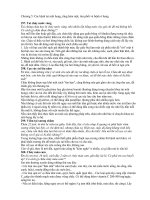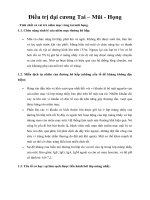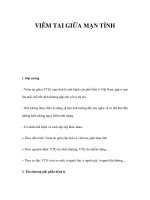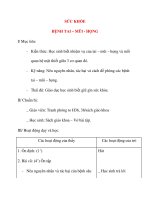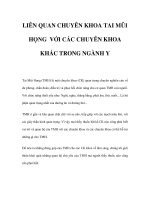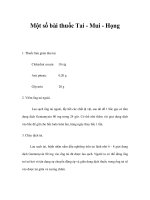VIÊM TAI GIỮA mạn TÍNH (TAI mũi HỌNG)
Bạn đang xem bản rút gọn của tài liệu. Xem và tải ngay bản đầy đủ của tài liệu tại đây (12.78 MB, 40 trang )
VIÊM TAI GIỮA MẠN TÍNH
Chronic Suppurative Otitis Media (CSOM)
Nội dung
•
•
•
•
•
Sơ lược giải phẫu và sinh lý tai giữa
Giới thiệu về bệnh CSOM
Lâm sàng
Cận lâm sàng
Điều trị
Anatomy of the Ear
• The ear is divided into 3 sections based on
function:
– Outer Ear
– Middle Ear
– Inner Ear
Anatomy of the Outer Ear
• Outer Ear
– The part of the ear visible from outside the
body
•
•
Pinna
Ear canal
– Function of the outer ear
•
•
Collect sound and direct it toward the tympanic
membrane
Protect the ear canal and tympanic membrane
Embryology of the ear
Embryology of the ear
Anatomy of the Middle Ear
• Middle Ear
–
Tympanic membrane
•
–
Eardrum converts acoustic
sound to mechanical energy
Ossicles
•
•
•
Incus
Malleus
Stapes
Anatomy of the Middle Ear
Anatomy of the Middle Ear
Anatomy of the Middle Ear
• Middle ear focuses mechanical
energy on the footplate of stapes
• Difference in surface area from
eardrum to footplate of stapes
• “Impedance matching”
• Middle ear increases incoming
signal by 30 dB
Anatomy of the Middle Ear
• Eustachian Tube
– The Eustachian tube
connects the middle ear
cavity with the back of the
throat
– It opens when we swallow
or yawn
•
•
Equalizes pressure on both
sides of the eardrum
Eardrum is most efficient
when there is equal
pressure on both sides
Anatomy of the Inner Ear
• Inner ear
– The inner ear is contained
within the skull
– Function of the inner ear:
•
•
Convert mechanical energy from
the middle ear to nerve impulses
which are sent to the brain
Responsible for balance system
Anatomy of the Inner Ear
• Semicircular canals control
balance
– Filled with fluid and hair cells
like the hearing part of the
cochlea
– Changes in position of head
cause nerves to fire
– This function of the ear is not
hearing related
Anatomy of the Inner Ear
• Action of the cochlea
–
–
–
–
Footplate of stapes connects at oval window
Cochlea is filled with fluid
Cochlea is partitioned by the basilar membrane
Organ of Corti sits on the basilar membrane
Semicircular
Canal
Oval
Window
Round
Window
Basal End
Basilar
Membrane Helicotrema
Scala Vestibuli
Scala Tympani
Apical End
Anatomy of the Inner Ear
• Action of the cochlea
– When footplate of stapes
moves in the oval window,
fluid is displaced in the
cochlea
– Haircells imbedded in the
tectoral membrane move
according to the frequency
and energy of the incoming
signal
Scala Vestibuli
Scala Media
Reissner’s Membrane
Tectorial Membrane
Nerve Fibers
Scala Tympani
Basilar Membrane
Drawing by S. Blatrix,
Promenade ‘Round the Cochlea
Anatomy of the Inner Ear
Cilia
• Action of the cochlea
– Outer hair cells move with
the incoming signal
amplifying the signal
– Inner hair cell sends a
nerve impulse to the brain
via the Auditory or 8th
Nerve
Tectorial
Membrane
Inner Hair
Cells
Basilar
Membrane
Stria
Vascularis
Drawing by S. Blatrix,
Promenade ‘Round the Cochlea
Outer
Hair
Cells
Anatomy of the Auditory Pathway
• The Auditory nerve carries
the impulses through the
brain stem
– 80% of the impulses cross
over to the opposite side in
the brain stem
• The impulses are
transmitted to the
auditory cortex in the
temporal lobe of the brain
Drawing by S. Blatrix,
Promenade ‘Round the Cochlea
Introduction
• Bệnh lý phổ biến, được biết đến
từ lâu
• Định nghĩa: “CSOM là tình trạng
chảy tai kéo dài kèm theo lỗ
thủng màng nhĩ”
• Phân biệt OME: Otitis Media
with Effusion
Introduction
• Người Ai Cập cổ: mỡ vịt, muối borax,và sữa bị.
• Các thầy thuốc Ấn Độ: điều trị bao gồm thuốc
và thay đổi lối sống: uống bơ, giữ im lặng, và
tránh mệt nhọc.
• Hippocrates: phân biệt AOM và CSOM
– Xơng nước nóng, sữa người, rựu vang đỏ, trán ánh
sáng, gió mạnh và khói.
– chì oxide and chì carbonate.
Pathophysiology
Acute
infection
Granulation
tissue
Mucosal
edema
CSOM
Vòng xoắn bệnh lý
→huỷ hoại xương
Mucosal
ulceration
Breakdown of
the epithelial lining
→biến chứng
Microbiology
• P aeruginosa: 48-98%
– P aeruginosa: → proteases, lipopolysaccharide, và một số men để
ngăn chặn phản ứng miễn dịch của cơ thể→phá huỷ xương→biến
chứng
• S aureus: vi khuẩn thường gặp thứ 2, chiếm 15-30% các
trường hợp cấy vi khuẩn (+).
• Các trường hợp còn lại do 1 số vi khuẩn gram âm:
Klebsiella (10-21%) và Proteus (10-15%)
• 5-10% CSOM: nhiễm đa khuẩn: gram-negative organisms
and S aureus. Vi khuẩn kị khí (Bacteroides,
Peptostreptococcus, Peptococcus) và nấm (Aspergillus,
Candida).
• 20-50% CSOM: nhiễm khuẩn kị khí→liên quan
cholesteatoma.
• Nấm chiếm 25% CSOM, vai trị bệnh sinh chưa rõ.
Frequency
• In the US:
– Lỗ thủng màng nhĩ càng lớn, nguy cơ CSOM càng cao
– Ventilation tube: 21-50% diễn tiến CSOM
– Tỷ lệ CSOM:39 cases per 100,000 persons in children
and adolescents aged 15 years and younger.
• Internationally:
– In Britain, 0.9% of children and 0.5% of adults have
CSOM.
– In Israel, only 0.039% of children are affected.
Dịch tễ
• Mortality/Morbidity:
– Yếu tố xã hội của CSOM
– Biến chứng: do biến chứng nội sọ
• Race:
– The American Indian (8%) and Eskimo (12%)
– Anatomy and function of the eustachian tube: wider and more
open→ nasal reflux
– Trẻ em các dân tộc thuộc Guam, Hong Kong, South Africa, and the
Solomon Islands.
• Sex: khơng khác biệt giữa nam và nữ.
• Age: 39 cases per 100,000 trẻ em và thiếu niên <15t.
CLINICAL
• History: chảy tai tái diễn từng đợt, tiền sử sau
AOM, chấn thương thủng nhĩ, đặt ống thơng khí,
khơng đau
• Triệu chứng thơng thường là nghe kém bên tai
bệnh
• Sốt, chóng mặt, đau: chú ý biến chứng nội sọ hay
xương thái dương
• CSOM kéo dài khơng đáp ứng điều trị nội khoa
thích hợp: gợi ý cholesteatoma
CLINICAL
• Physical:
– Ống tai ngồi: có hoặc khơng nề
– Dịch tai: thay đổi từ hơi, mủ, giống phó
mát cho đến dịch trong và sạch
– Mô hạt: khoang tai giữa
– Niêm mạc tai giữa: phù nề, polyp, tái nhợt
hoặc xung huyết
